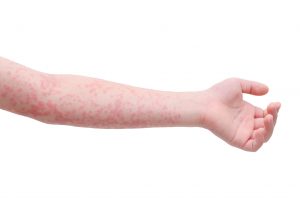 Throughout the spring season, there are a number of different ways your child can become sick, leading to common symptoms such as a sore throat, runny nose, fever, or stomach problems. In some cases, these issues may only be a result of seasonal allergies to substances such as pollen. However, these symptoms could also occur due to an infectious disease, such as the common cold or flu.
Throughout the spring season, there are a number of different ways your child can become sick, leading to common symptoms such as a sore throat, runny nose, fever, or stomach problems. In some cases, these issues may only be a result of seasonal allergies to substances such as pollen. However, these symptoms could also occur due to an infectious disease, such as the common cold or flu.
Children develop infections due to either viruses or bacteria. A virus is a piece of genetic material surrounded by protein that requires a living host; when it infects something, it takes control of the host’s cells and uses them to create more of the virus. Some examples of common pediatric viral infections include:
- Influenza
- Colds
- Respiratory Syncytial Virus (RSV)
- Gastroenteritis (Stomach Flu)
- Chickenpox
- Bronchitis
Bacteria are single-celled organisms that live in a variety of different environments; most cause no harm to humans, with some even aiding in bodily processes such as digestion, but others may cause illnesses to develop in certain parts of the body. Common bacterial infections in children include:
- Strep throat
- Ear infections
- Impetigo
Some infections may also be caused by either a virus or bacteria. These include:
- Pneumonia
- Meningitis
- Diarrhea
Knowing the cause of your child’s infection is important, as this will determine the type of medicine they will need. Viruses are treated with antiviral medication, while bacterial infections are treated with antibiotics. Trying to treat your child’s infection with the wrong type of medication will not work, and in some cases could even lead to negative side effects.
Both antiviral medication and antibiotics can only be obtained with a prescription. A doctor can determine the most likely cause of your child’s infection and prescribe them with the appropriate medication for effective treatment results. You can schedule an appointment with a pediatrician at Forest Hills Pediatric Specialists by calling (718) 704-5020.
All content of this newsletter is intended for general information purposes only and is not intended or implied to be a substitute for professional medical advice, diagnosis or treatment. Please consult a medical professional before adopting any of the suggestions on this page. You must never disregard professional medical advice or delay seeking medical treatment based upon any content of this newsletter. PROMPTLY CONSULT YOUR PHYSICIAN OR CALL 911 IF YOU BELIEVE YOU HAVE A MEDICAL EMERGENCY.


